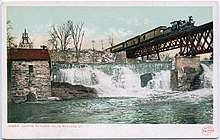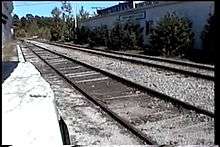Rutland Railroad
The Rutland Railroad (reporting mark RUT) was a railroad in the northeastern United States, located primarily in the state of Vermont but extending into the state of New York at both its northernmost and southernmost ends. After its closure in 1963 parts of the railroad were taken over by the State of Vermont and are now operated by the Vermont Railway.
| Overview | |
|---|---|
| Reporting mark | RUT |
| Locale | New York and Vermont |
| Dates of operation | 1843–1963 |
| Successor | Vermont Railway |
| Technical | |
| Track gauge | 4 ft 8 1⁄2 in (1,435 mm) standard gauge |
Construction and early years
.jpg)
The earliest ancestor of the Rutland, the Rutland & Burlington Railroad, was chartered in 1843 by the state of Vermont to build between Rutland and Burlington. When the Vermont legislature created the state railroad commission in 1855 to oversee railway construction, maintenance, and operations, the first person appointed to the position was Charles Linsley, the Rutland and Burlington's counsel, and a member of its board of directors.[1] A number of other railroads were formed in the region, and by 1867 the Rutland & Burlington Railroad had changed its name to simply the Rutland Railroad.[2]
Between 1871 and 1896 the Rutland Railroad was leased to the Central Vermont, regaining its independence when that road entered receivership. The New York Central Railroad briefly had a controlling interest in the Rutland from 1904, but sold half of its shares to the New York, New Haven & Hartford Railroad in 1911.
In 1901, the Rutland Railroad completed construction of a system of causeways and trestles across Lake Champlain, through the Champlain islands, to connect between Burlington, Vermont and Rouses Point, New York. The purpose of this construction was to give the Rutland access to Canada independent of the tracks of the competing Central Vermont. At the final approach to Rouses Point, though, both companies did end up sharing the same bridge over the Richelieu River by using an unusual gauntlet track that allowed sharing without the need for switches.[3] The causeway between Burlington and South Hero built at that time is today maintained as a recreation trail called The Island Line Trail.[4] The company also had a line from Rutland, southeast to Bellows Falls, in southeastern Vermont, opposite New Hampshire, and a line from Rutland south to North Bennington, thence to Chatham, New York. Chatham was a major junction for connections via the New York Central to New York City and the Boston & Albany Railroad service to Massachusetts.[5]
The railroad operated a day passenger train, the Green Mountain Flyer, and a night train counterpart, the Mount Royal, from Montreal to New York City, via Burlington and Rutland.
The Rutland's primary freight traffic was derived from dairy products and to many the railroad is fondly remembered for the long trains of milk that used to move over the system. At its peak the Rutland served about a 400-mile (600 km) system that roughly resembled an upside-down "L" running from Chatham, New York north to Alburgh, Vermont (the railroad's northernmost terminus was Noyan, Quebec) and thence west to Ogdensburg, New York along the St. Lawrence River. Never a solid financial operation, the Rutland entered receivership for the first time in 1938. Cost cutting, including wage reduction, brought things around. A reorganization in 1950 changed the name from Rutland Railroad to Rutland Railway.
In 1925, Rutland reported 259 million net ton-miles of revenue freight and 38 million passenger-miles on 413 miles of road and 559 miles of track; in 1960 it had 182 million ton-miles on 391 route-miles and 476 track-miles.
Decline


After World War II the decline continued; many branches were closed down. In 1950 the company was reorganized as the Rutland Railway. The year 1953 brought three weeks of employee strike action, which killed off the remaining passenger service on the line. In 1955, the Rutland retired its last steam locomotives.
In 1961 after further strikes the railroad apparently decided it was no longer viable and applied to the Interstate Commerce Commission for complete abandonment. This was approved, and the railroad closed down on May 20, 1963. The strike was brought on by the employees' unwillingness to accept changes that would have moved the center of operations from Rutland to Burlington, requiring them to relocate from Rutland to Burlington. The railroad's tracks in New York State, from the Vermont border directly west of Bennington, along the eastern towns of Rensselaer County south to Chatham, New York were removed, sealing off the previous connection in Chatham to New York City's Grand Central Terminal via the New York Central's Harlem Line.
The changes would have lengthened the runs, running from Burlington to Bellows Falls or Ogdensburg on one day, staying over and then running back the next day. Under current operating orders they would make the run from Rutland to Burlington or Bellows Falls and back in a day, or from Malone, New York running out and back to Ogdensburg and Burlington.
A few years later the national unions agreed to nationwide job changes that allowed this type of change.
Much of the right-of-way was purchased by the State of Vermont. The Northern Division across the top of New York State from Ogdensburg to Norwood remains in tracks. It is operated by Vermont Railway, so all the remaining trackage of the Rutland is operated by one company. Ownership of the railbed from Norwood to Burlington has been dispersed, but a 21-mile (34 km) section from Norwood to Moira is the multi-use Rutland Trail. Other abandoned sections make up all or part of the Hudson and Delaware Rail Trail, Corkscrew Rail Trail and the Alburg Recreation Rail Trail.
Steamtown
Until it was relocated to Scranton, Pennsylvania, The Steamtown Foundation, located near the Bellows Falls terminus operated tourist trains between the museum site and Chester, Vermont.
Following Steamtown’s departure, several tourist trains using the original Rutland rolling stock were operated.
See also
References
- Ellingson, Barbara (1997). "Biographical Sketch, Charles Linsley" (PDF). Charles and Emmeline Linsley Papers, 1827-1892. Montpelier, VT: Vermont Historical Society. p. 1. Retrieved July 3, 2018.
- Lindsell 2000, p. 41.
- Lindsell 2000, p. 43.
- Baird, Joel Banner (June 20, 2011). "Causeway bike ferry canceled for season". Burlington Free Press. Burlington, Vermont. Archived from the original on January 18, 2013. Retrieved March 15, 2012.
- "An Eastern Regional Railroad - 1930's - 1940's, Rutland Railroad".
- Lindsell, Robert M. (2000). The Rail Lines of Northern New England. Pepperell, MA: Branchline Press. ISBN 0942147065.
External links
- Rutland Railway Association
- Rutland Railroad Historical Society
- The Rutland on George Elwood's Fallen Flags site.
- Lisbon Town link Lisbon Historian link Lisbon NY's Lisbon Depot Museum (in former Rutland station, displays many Rutland items).
- The Rutland Railroad, 'The Green Mountain Gateway'